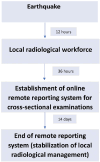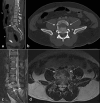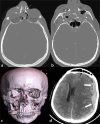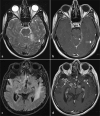Earthquakes from a radiological perspective: what is demanded from the radiologists, and what can we do? A pictorial review
- PMID: 37095695
- PMCID: PMC10773182
- DOI: 10.4274/dir.2023.232157
Earthquakes from a radiological perspective: what is demanded from the radiologists, and what can we do? A pictorial review
Abstract
Earthquakes are among the most destructive and unpredictable natural disasters. Various diseases and ailments, such as bone fractures, organ and soft-tissue injuries, cardiovascular diseases, lung diseases, and infectious diseases, can develop in the aftermath of severe earthquakes. Digital radiography, ultrasound, computed tomography, and magnetic resonance imaging are significant imaging modalities utilized for the quick and reliable assessment of earthquake-related ailments to facilitate the planning of suitable therapy. This article examines the usual radiological imaging characteristics observed in individuals from quake-damaged regions and summarizes the strengths and functionality of imaging modalities. In such circumstances, where quick decision-making processes are life-saving and essential, we hope this review will be a practical reference for readers.
Keywords: Earthquakes; compartment syndromes; crush injuries; disasters; embolism; emergencies; multiple trauma; radiology information systems.
Conflict of interest statement
Sonay Aydın, MD, is Section Editor in Diagnostic and Interventional Radiology. He had no involvement in the peer-review of this article and had no access to information regarding its peer-review. Other authors have nothing to disclose.
Figures




















Similar articles
-
Radiological perspective on earthquake trauma: differences in children and adults.Rev Assoc Med Bras (1992). 2024 Nov 11;70(10):e20240683. doi: 10.1590/1806-9282.20240683. eCollection 2024. Rev Assoc Med Bras (1992). 2024. PMID: 39536252 Free PMC article.
-
Emergency radiology after a massive earthquake: clinical perspective.Jpn J Radiol. 2018 Nov;36(11):641-648. doi: 10.1007/s11604-018-0771-y. Epub 2018 Aug 25. Jpn J Radiol. 2018. PMID: 30145659 Review.
-
Earthquake-related pelvic crush fracture vs. non-earthquake fracture on digital radiography and MDCT: a comparative study.Clinics (Sao Paulo). 2011;66(4):629-34. doi: 10.1590/s1807-59322011000400018. Clinics (Sao Paulo). 2011. PMID: 21655758 Free PMC article.
-
Assessment of pelvic fractures resulting from the 2010 Haiti earthquake: opportunities for improved care.J Trauma Acute Care Surg. 2014 Mar;76(3):866-70. doi: 10.1097/TA.0000000000000098. J Trauma Acute Care Surg. 2014. PMID: 24553562
-
Radiological management and challenges of the twin earthquakes of February 6th.Emerg Radiol. 2023 Oct;30(5):659-666. doi: 10.1007/s10140-023-02162-5. Epub 2023 Aug 3. Emerg Radiol. 2023. PMID: 37535144 Review.
Cited by
-
February 6th, Kahramanmaraş earthquakes and the disaster management algorithm of adult emergency medicine in Turkey: An experience review.Turk J Emerg Med. 2024 Apr 4;24(2):80-89. doi: 10.4103/tjem.tjem_32_24. eCollection 2024 Apr-Jun. Turk J Emerg Med. 2024. PMID: 38766417 Free PMC article. Review.
-
Radiological perspective on earthquake trauma: differences in children and adults.Rev Assoc Med Bras (1992). 2024 Nov 11;70(10):e20240683. doi: 10.1590/1806-9282.20240683. eCollection 2024. Rev Assoc Med Bras (1992). 2024. PMID: 39536252 Free PMC article.
-
Radiological findings of February 2023 twin earthquakes-related spine injuries.World J Radiol. 2024 Sep 28;16(9):398-406. doi: 10.4329/wjr.v16.i9.398. World J Radiol. 2024. PMID: 39355384 Free PMC article.
-
Emergency Radiology in the First 24 h of Two Major Earthquakes on the Same Day and Radiologic Evaluation of Trauma Cases.Tomography. 2024 Aug 22;10(8):1320-1330. doi: 10.3390/tomography10080099. Tomography. 2024. PMID: 39195734 Free PMC article.
References
-
- Ishihara O, Yoshimura Y. Damages at Japanese assisted reproductive technology clinics by the Great Eastern Japan Earthquake of 2011. Fertil Steril. 2011;95(8):2568–2570. - PubMed
-
- United States Geological Survey (USGS), Earthquakes maps, Accessed February 15, 2023. [Internet]
-
- Anadolu Agency Infographics, Accessed February 15, 2023. [Internet]
-
- Earthquake news, Accessed March 8, 2023. [Internet]
-
- Iyama A, Utsunomiya D, Uetani H, et al. Emergency radiology after a massive earthquake: clinical perspective. Jpn J Radiol. 2018;36(11):641–648. - PubMed
Publication types
MeSH terms
LinkOut - more resources
Full Text Sources
Medical

